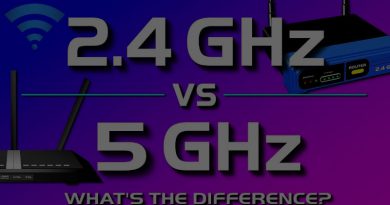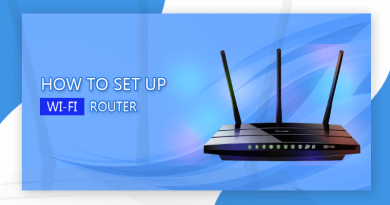What is WiFi 6 – The NEW WiFi Names
If your current WiFi connection is not sufficiently strong to support your growing number of devices, you may be looking for a better solution. You may encounter frequent connection errors, slowdowns, and other technical problems. WiFi 6 will provide faster, more secure communication.
We have come a long way from the early wireless routers that we had seen almost 20 years ago. Wi-Fi has gone from being high-tech to a product that is virtually everywhere.
Now we are about to see the launch of a new generation of Wi-Fi apps. The various Wi-Fi types have long had confusing names but the Wi-Fi Alliance has changed the present, past, and next-generation of Wi-Fi to remove confusion.
We’ll clarify what’s going on and why it’s going to be important for potential wireless devices that you’re going to have at home. We’ll also take a look at the new Wi-Fi 6 (802.11ax) routers.
In Wi-Fi technology, we’ll talk more about this next-generation standard, tell you what it has to offer, and provide tips on how to decide which devices are compliant with Wi-Fi6.
What is Wi-Fi 6?
Wi-Fi 6 is the new name given to one of the newest Wi-Fi standards that consumer electronics devices, including phones, tablets, laptops, and routers, use.
The previous name was ‘IEEE 802.11ax,’ and the industry body that tests and certifies Wi-Fi devices, the Wi-Fi Alliance, agreed that some snappier names were required after 21 years after the first Wi-Fi standard was released. The preceding standard, 802.11ac, was also retroactively dubbed as Wi-Fi 5.
Not only it is much easier to read and pronounce, but these new labels will also give customers a clear idea of what kind of Wi-Fi output is there and what new tech that you could expect.
The new update provides a speed increase, of course, but on challenging networks, such as those found in congested public areas – airports, stadiums, and so on, you can also expect more stable results. That’s because they now support more apps simultaneously.
As if that wasn’t enough, Wi-Fi 6 is also more power-efficient, helping some products, particularly smart home, and IoT? (internet of things) devices, improve battery life.
The dawn of generational Wi-Fi labels
The Wi-Fi Alliance is the organization that is responsible for the decision, development, and designation of Wi-Fi standards. The method of supplying wireless communications has changed as computers became more sophisticated and internet networks grew. It means that Wi-Fi standards — the technical specifications that manufacturers use to create Wi-Fi — need to be updated periodically so that new technology can flourish and all compatibility remains.
But the awkward naming of Wi-Fi protocols has become a major nuisance for the average citizen who has been trying to find out what those little letters mean at the top. The Wi-Fi Alliance is aware of this, which is why they introduced a new method of marking Wi-Fi specifications, simply by pointing to the generation number. This will apply to the new Wi-Fi 6 which will still refer to older requirements in a retroactive way.
For example:
- 11n (2009) = Wi-Fi 4
- 11ac (2014) = Wi-Fi 5
- 11ax (2019) = Wi-Fi 6
Easier, isn’t it? This will create a time of confusion in which certain items are branded with the old code and others are named Wi-Fi 4 or Wi-Fi 5 although it means the same. It will be resolved over time when older product identification is phased out and while conducting research everybody gets used to the modern, familiar names. The Wi-Fi protocols you use in your home have been updated, and as we reported, the upcoming Wi-Fi standard (802.11ax), which is called Wi-Fi 6, has a new name. Wireless standards were traditionally referred to as a formal name – the name the IEEE, which is the organization that defines networking standards, initially gave them. It should be noted that all of the wireless standards listed here are backward compatible. So when Wi-Fi 6 is introduced to your devices, it will be compatible with your current setup.
The titles would be easier to understand. If you have a new router from the last few years, it will support 802.11ac and older standards like 802.11n. And, it’ll endorse Wi-Fi 5 and 6 under the current nomenclature.
What the Wi-Fi 6 standard brings
Now that we’ve addressed the topic of naming, you still wonder what Wi-Fi 6 is going to bring to the table. What did they need another update? Many new Wi-Fi innovations are on the rise, and Wi-Fi 6 is helping to standardize them. Below are the main new pieces, and exactly what they mean for your wireless network.
The latest Wi-Fi standard provides faster data transfer speeds, as usual. If you are using a single-device Wi-Fi router, the maximum theoretical speeds with Wi-Fi 6 will be up to 30-40 percent higher than Wi-Fi 5.
Wi-Fi 6 accomplishes this by encoding data more effectively, which results in higher throughput. More data is mainly packaged into the same radio waves. The chips encoding and decoding these signals continue to become more efficient, and can handle the extra work.
This latest standard also improves speeds on networks with 2.4GHz. Although the industry has moved to 5GHz Wi-Fi for less interference, the penetration of solid objects by 2.4GHz is still higher.
And there shouldn’t be as much interference for 2.4GHz as old cordless telephones and wireless baby monitors are retired.
Wi-Fi 6 (or 802.11ax) offers an increase in the speed of about 30-40 percent, but the improvements are broader than just a headline figure.
Latency can also be reduced dramatically because the way it manages many devices is key to this iteration of Wi-Fi – it will be able to send even more data to each user at the same time.
And yes, that means that in places where you have a vast number of devices – such as exhibitions, press conferences, stadiums and the like – in the future we should be getting more robust networks.
Wi-Fi 6 routers have different sources of wireless connectivity, as a result of which different products can manage various quantities of connected devices (essentially you can think of them as ‘pipes’ with room for a fixed amount of data). The strongest is with eight or twelve sources.
Longer life of the battery
A new “Target Wake Time” (TWT) feature ensures that your smartphone, laptop, and other Wi-Fi – enabled devices will now have longer battery life.
When the access point communicates to a device (such as your smartphone), it will tell the system exactly when to put the Wi-Fi radio to sleep and exactly when to wake it up to receive the next transmission. This will conserve power, which means that the Wi-Fi radio can spend more time in sleep mode. And this means a longer battery life.
Better efficiency in crowded areas
If you’re in a busy place with lots of Wi-Fi activated apps, Wi-Fi appears to get bogged down. Imagine a busy stadium, airport, hotel, mall, or even a packed office with everyone linked to Wi-Fi. You ‘re likely to have a sluggish Wi-Fi.
The new Wi-Fi 6, also known as 802.11ax, incorporates some new technologies to help with this. Intel trumpets that Wi-Fi 6 would increase the average speed of each user by “at least four times” in congested areas with a lot of connected devices.
It wouldn’t only refer to busy public places. This could relate to you at home if you have a lot of devices linked to Wi-Fi, or if you live in a dense apartment complex.
How Wi-Fi 6 Battles Overcrowding
You don’t have to know all the specifics. Wi-Fi 6 access point would work better with Wi-Fi 6 system. But here’s what happens under the hood:
Wi-Fi 6 is now capable of dividing a wireless channel into a large number of subchains. These sub-channels can carry data that is intended for another computer. It is done by something called Multiple Access, or OFDMA, or Orthogonal Frequency Distribution. The Wi-Fi access point would be able to connect to multiple devices at once.
MIMO — Multiple In / Multiple Out has also improved with the current riderless model. This involves multiple antennas that allow the access point to talk to multiple devices simultaneously. With Wi-Fi 5, the access point could speak to devices simultaneously, but those devices could not respond simultaneously. Wi-Fi 6 has an improved Multi-User or MU-MIMO version that allows devices to respond simultaneously to the wireless access point.
Wireless access points can be broadcast on the same cable, near each other. In this case, before replying the radio listens and waits for a clear signal. With Wi-Fi 6, you can configure wireless access points near each other to have different “colors” of the Basic Service Set (BSS). This “color” is just a number between 0 and 7. If a device checks if the channel is clear and listens in, a transmission with a weak signal and a different “color” may be noticed. Then it can ignore this signal and transmit it without waiting, thus improving performance in congested areas and is also called “spatial frequency reuse.”
Those are just some of the most interesting aspects but there are still several minor changes to the current WI-Fi standard. For example, Wi-Fi 6 would also incorporate enhanced beamforming.
How fast is the new Wi-Fi 6 standard?
Whether you name it Wi-Fi 6 or 802.11ax, the newer standard provides theoretical speeds up to 10Gbps, but one of the standard’s key aims is to make Wi-Fi function better with multiple devices. There are several important improvements in how Wi-Fi 6 operates.
Firstly, the standard has increased the number of bits which can be transmitted simultaneously. Wi-Fi employs the Quadrature Amplitude Modulation (QAM) method. Wi-Fi 5 used 512-QAM which allows the device to transmit eight bits at once; Wi-Fi 6 uses 1024-QAM which allows the transmission of 10 bits at the same time. That gives an increase in the speed of 25 percent.
First, Wi-Fi 6 uses the Multiple Access (OFDMA) Orthogonal Frequency Division, which breaks down a wireless channel into small bits, so that each client gets its dedicated bandwidth. It’s similar to how you would fill a post truck with letters for various individuals, then separate at the end.
MU-MIMO has also received a boost. With this technology, a router can upload and download a set number of streams. An 8 router has eight uploads and eight download sources, for example. With MU-MIMO you can direct a stream to a client, giving them bandwidth. There is an option as to how it should be achieved. For example, a 2 range2 client could connect to both streams to improve capacity, thereby allowing our 8 range router to support up to four clients; however, the router could link eight clients directly using a single stream each. The main thing is that the more sources you have, the easier it’s for more clients to fund the router.
For Wi-Fi 5, MU-MIMO was added, but only for downloads, but Wi-Fi 6 makes the system bidirectional. And, at the same time, MU-MIMO can be used with OFDMA, enhancing the response and the dedicated bandwidth which each client gets.
In the 5GHz band, channel width was increased from 80MHz to 160MHz, further expanding the usable bandwidth; with the congested 2.4GHz band, channel width remains at 40MHz.
Thanks to Target Wake Time, power saving is improved with Wi-Fi 6. Clients and the router will use this system to plan when routine communications will take place. This saves battery life for devices that need to be checked in from time to time, such as a smart sensor, as the device only needs to communicate when scheduled; with the old system, the device would need to wake up, try and transmit but return if the Wi-Fi network was in use, then try again.
Target Wake Time does not make a difference on your laptop, which can talk much more but this technology will boost connectivity and battery life for sensors, smart home devices.
Wi-Fi 6 is a standard that operates on both the 2.4GHz and 5GHz bands, and it applies to both. By way of contrast, Wi-Fi 5 was just a 5GHz standard and routers also used the older 2.4GHz band 802.11n specification.
As a result, Wi-Fi 6 extends its functionality across all bands, offering more overall high-quality bandwidth; however, devices can still only link to one form of the network at a time: routers may either provide two different channels or provide a single network name, and send connecting devices to the best channel based on speed, range, and capabilities.
What are Wi-Fi standards?
Each new Wi-Fi standard that comes along introduces our wireless networks to develop and refine them. As the name sort of suggests, Wi-Fi 6 is the sixth generation of such norms.
Here’s a full table of previous Wi-Fi standards that includes their old and new names, maximum speeds, and other relevant information.
Remember that the Wi-Fi Alliance has not officially rewritten the three generations before Wi-Fi 4, because they are now gone and will not be sought or sponsored by any new product.
On speeds, you should remember that the speeds provided here are theoretical maximum speeds – even if you have the latest phones and laptops, if there are other devices in your home that all use the same link, or you’re moving closer or further away from your router (and you don’t have a mesh Wi-Fi network configured), then your speed that differs.
You’ll need the appropriate hardware to take full advantage of Wi-Fi 6 and its upgrades. For one, you will need a router compatible with 802.11ax. Additionally, any system connecting to that router should have the correct Wi-Fi 6 antenna.
Wi-Fi specifications also ensure the backward compatibility of the devices. In other words, older connected devices that don’t meet the latest standards will still connect happily to a Wi-Fi 6 router. They are just not going to be able to capitalize on those updates. Likewise, any Wi-Fi-compatible smartphones, laptops, and other devices can hook up to a router using Wi-Fi 5.
What is a 5GHz Wi-Fi? Is that the same as 5G and Wi-Fi 5?
Wi-Fi has been using two radio frequencies since the beginning-2.4GHz or 5GHz.
The frequency of 2.4GHz is quite crowded since everything from automatic garage doors to old-school baby monitors is used. Bluetooth, another popular wireless technology, also occupies the 2.4GHz band.
The excess noise is why Wi-Fi requirements have been extended to the much faster 5GHz band.
These days, most modern routers and client devices are dual-band, meaning they send and receive data over both the 2.4GHz and 5GHz frequencies.
Then you can select which band to connect on your wireless system so that it uses both as well. You may wonder why someone is trying to use the 2.4GHz band given an option between the two. This frequency, however, is more effective in passing through obstacles like floors and walls – it’s a great news if you live in a massive house and don’t have a Wi-Fi mesh setup.
Wi-Fi 5 is the latest name, launched in 2013, for the 802.11ac standard Wi-Fi. While you can expect to see it replaced with Wi-Fi. This is what most modern wireless devices use.
When will Wi-Fi 6 be available?
In September 2019 the Wi-Fi Alliance began providing Wi-Fi 6 certification to 802.11ax users. The first two products confirmed to be Wi-Fi 6 approved by the Wi-Fi Alliance are the Samsung Galaxy S10 and the Ruckus R750 wireless access point.
A number of Wi-Fi 6 approved routers have become available since the introduction of those two devices. The Wi-Fi Alliance has a product finder page which will be the first stop for anyone looking to purchase approved Wi-Fi 6 smartphones, computers, or access points. If it is not on that list, it is not accredited, and that means it does not endorse the speed, functions, or protection of a certified product, nor can it guarantee it.
Bad news for Apple users: As of late April 2020 there is no single Apple device listed as Wi-Fi 6 approved. Samsung fans are in another boat, as many of its products are already certified. Microsoft has approved the newest Surface models, too.
If the devices you are interested in are not listed, keep an eye out for the manufacturer’s or Wi-Fi Alliance announcement. Nonetheless, you might be waiting for a while: there is no way to say how easily a product can move through the certification process, and there is possibly a large backlog since certification only started in September 2019.
For the introduction of the 6GHz band to the channel and frequency range of Wi-Fi, a new category of certifications is being added: Wi-Fi 6E. Do not expect Wi-Fi 6E certified devices to be available in the immediate future: the Wi-Fi Alliance said it would not start certifying devices for 6GHz Wi-Fi 6E until early 2021. As with early Wi-Fi 6 devices, be careful about routers that will release their 6GHz capabilities shortly: without certification, it is impossible to know how well the device will perform on 6GHz channels if any.
It’s good that the model numbers are now understandable to most of us. It’s a simple, easy change that ought long ago to have been made. This would make using Wi-Fi much simpler for average citizens. After all, by updating their home routers, many people can get faster Wi-Fi speeds.




